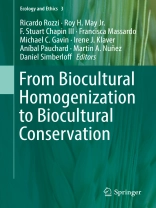To assess the social processes of globalization that are changing the way in which we co-inhabit the world today, this book invites the reader to essay the diversity of worldviews, with the diversity of ways to sustainably co-inhabit the planet. With a biocultural perspective that highlights planetary ecological and cultural heterogeneity, this book examines three interrelated themes: (1) biocultural homogenization, a global, but little perceived, driver of biological and cultural diversity loss that frequently entail social and environmental injustices; (2) biocultural ethics that considers –ontologically and axiologically– the complex interrelationships between habits, habitats, and co-inhabitants that shape their identity and well-being; (3) biocultural conservation that seeks social and ecological well-being through the conservation of biological and cultural diversity and their interrelationships.
Inhaltsverzeichnis
FOREWARD.- 1. From Biocultural Homogenization to Biocultural Conservation: A Conceptual Framework to Reorient Society Toward Sustainability of Life.- 2. Biocultural Homogenization: a wicked problem in the Anthropocene .- 3. Re-Claiming Rivers from Homogenization: Meandering and Riverspheres.- 4. Biostitutes and Biocultural Conservation: Empire and Irony in the Motion Picture Avatar.- 5. The Political Ecology of Land Grabs in Ethiopia .- 6. The Ongoing Danger of Largescale Mining on the Rio Doce: an Account of Brazil’s Largest Biocultural Disaster.- 7. Land Grabbing and Violence against Environmentalists.- 8. The Changing Role of Europe in Past and Future Alien Species Displacement.- 9. Dürer’s Rhinoceros: Biocultural Homogenization of the Visual Construction of Nature.- 10. Biocultural Exoticism in the Feminine Landscape of Latin America.- 11. Biocultural Homogenization in Modern Philosophy: David Hume’s noble Oyster.- 12. Nature, Culture, and Natureculture: The Role of Nonnative Species in Biocultures.- 13. Why Some Exotic Species are Deeply Integrated into Local Cultures While Others are Reviled.- 14. Fur Trade and the Biotic Homogenization of Sub-polar Ecosystems.- 15. Non-native Pines are Homogenizing the Ecosystems of South America.- 16. Biotic Homogenization of the South American Cerrado.- 17. Taxonomic and Phylogenetic Homogenization across US National Parks – The Role of Non-Native Species.- 8. Homogenization of Fish Assemblages off the Coast of Florida.- 9. Biocultural Conservation and Biocultural Ethics.- 20. The U.N. Sustainable Development Goals and the Biocultural Heritage Lacuna: Where is Goal Number 18?.- 21. Suma qamaña or Living Well Together: A Contribution to Biocultural Conservation.- 22. Biocultural Approaches to Conservation: Water Sovereignty in the Kayapó Lands.- 23. Biocultural Diversity and Ngöbe People in the South Pacific of Costa Rica.- 24. Candomblé in Brazil: The Contribution of African-origin Religions to Biocultural Diversity in the Americas.- 25. Latin American Theology of Liberation and Biocultural Conservation.- 26. The Dynamics of Biocultural Approaches to Conservation in Inner Mongolia, China.- 27. Challenging Biocultural Homogenization: Experiences of the Chipko and Appiko Movements in India.- 28. Revitalizing Local Commons: A Democratic Approach to Collective Management.- 29. The Garden as a Representation of Nature: A Space to Overcome Biocultural Homogenization?












